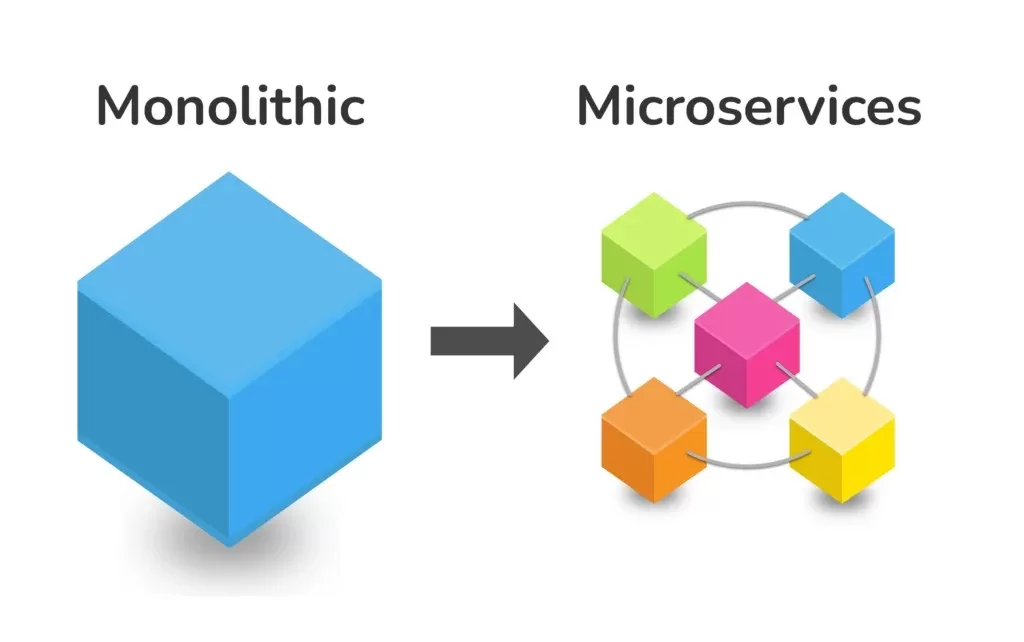Microservices vs Monolithic Architecture: Choosing the Best Approach for Your Software Development Project

Software development progress demands that architects together with developers need to decide between using microservices or monolithic architecture for their application design. Selecting the appropriate development method between microservice and monolithic architecture determines how successfully your project will perform.
This discussion introduces the characteristics of monolithic and microservices architecture followed by a look at their characteristics and setbacks. Our analysis includes studying actual companies that implemented each strategy with successful results and we will discuss the obstacles faced along with their obtained advantages.
What is Monolithic Architecture?
The monolithic architecture follows a traditional development pattern because it builds every application from one continuous massive block. The application lacks distinct boundaries between its database and business logic and graphical user interface since all elements maintain close ties with each other. This model consists of one significant container which contains all application elements side by side.
Pros of Monolithic Architecture:
1. The architectural design enables quick creation of deployable applications that can be easily tested during both development and deployment.
2. Better maintainability and scalability
3. Faster communication between components
4. Lower overhead costs
Cons of Monolithic Architecture:
1. Scalability limitations
2. The characteristics of tight coupling produce application rigidity which hampers flexibility.
3. Single point of failure
4. Difficult to adopt new technologies
Real-World Example: Netflix's Early Days
When they first started Netflix employed a monolithic design that proved advantageous at the beginning of their operations. Netflix executed their application with ease because their initial software was straightforward and compact. The company discovered structural problems with their old strategy after they started both growing in size and their business operations. The application experienced rising inflexibility while dealing with scalability problems. The company made a move to microservices architecture to gain better scaling capabilities and speed up innovation processes.
Real-World Example: Airbnb's Monolithic Architecture
Airbnb has managed to execute a monolithic architectural structure successfully. The small scale of their application enables them to control it with a competent team. Through proper planning and design their company has achieved high levels of scalability together with flexible functionality.
What are Microservices?
A microservices-based design of applications takes a large system into multiple independent services that operate autonomously. These business-capability-focused services share information through API connections that enable their interaction. The application structure operates similarly to numerous specialized containers which unite to produce an integrated system.
Pros of Microservices Architecture:
- Scalability and flexibility
- Reliability and robustness
- Easier integration of new technologies
- Improved innovation and iteration
Cons of Microservices Architecture:
- Increased complexity in development and management
- Higher overhead costs
- Communication and integration challenges
- Increased testing complexity
Real-World Example: Amazon's Microservices Architecture
Amazon serves as a leading showcase of how a company achieves success with microservices architecture. The system utilizes hundreds of individual services acting as single purpose controllers for different business capabilities. The implementation of this system allows Amazon to achieve unmatched business scalability and operational flexibility. They deliver new features and platform services at an outstanding speed through their rapid innovation capabilities.
Real-World Example: Uber's Microservices Architecture
The transportation company Uber utilizes a system of microservices architecture for their operations. The application consists of various services which control individual business capabilities. Through this strategy Uber has efficiently handled numerous requests throughout each day. Through their system they have managed to develop new features together with additional services frequently.
Real-World Example: Spotify's Microservices Architecture
Spotify functions as a streaming music service through its adoption of microservices architecture. The application at Spotify utilizes more than one hundred individual services to manage its business operations. Through this approach Spotify successfully operates its system while managing millions of users alongside millions of daily requests.
When to Choose Monolithic Architecture?
Projects of smaller or medium size along with simple specifications benefit most from monolithic architecture systems. This architecture solution works well for projects that have restricted scalability needs and demanding time requirements. A drawback of monolithic architecture occurs when the application expands because it creates rigid structures that limit flexibility.
When to Choose Microservices Architecture?
Organizations need to select microservices architecture because it meets the needs of extensive complex applications which require continuous expansion. The architectural approach provides excellent results for organizations that need various types of services. The management of microservices architecture remains challenging although it serves well as a technical solution.
Frequently Asked Questions:
What architectural design would be most suitable for my current project?
A: Consider the following factors:
1. Project size and complexity
2. Scalability requirements
3. Team size and expertise
4. Time-to-market constraints
5. Technology and integration requirements
When making decisions about monolithic or microservices architecture which solution is needed for my project can be determined through which of these factors?
A: Consider the following factors:
1. Project size and complexity
2. Scalability requirements
3. Team size and expertise
4. Time-to-market constraints
5. Technology and integration requirements
Using a microservices architecture provides several collective advantages to system development. A microservices architecture brings forth these additional advantages to the system:
1. Each microservice within this approach allows an independent scaling mechanism.
2. Each individual microservice maintains independent deployment possibilities which gives the system greater flexibility.
3. The architectural format provides greater resilience because service interruptions only affect the failed service without endangering the complete application.
4. Individual services maintain themselves more easily through microservices since updates do not impact overall application systems.
The main difficulties that emerge from employing microservices architecture methods are the following. A microservices architecture implementation presents several challenges to system developers which are:
1. High complexity levels result from this architecture because it contains multiple components that need management.
2. Unity between services presents challenges for microservices architecture because they need to communicate successfully.
3. Microservice deployment requires consistent data management between individual services while maintaining that task proves difficult to achieve.
4. Each microservice adds to the security requirements since each operates as an individual access point.
Best Practices for Implementing Microservices Architecture
Conclusion:
Your development project will achieve success only through selecting the proper architecture format. The monolithic architecture suits projects of small to medium scale alongside simple and straightforward requirements though microservices architecture serves large complex projects requiring high growth capabilities. Your decision selection will benefit from studying the benefits and limitations of different models so your project can reach its targeted characteristics.
Project evaluation must include aspects such as project scale and scalability needs along with team composition and expertise levels and time duration for development and technology and integration needs in order to determine monolithic or microservice selection. A successful software application can be developed for user needs when you implement proper planning along with execution.

